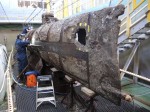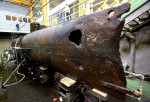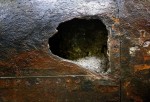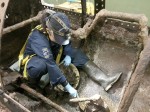 The iron body of the Confederate submarine H. L. Hunley has been revealed after 137 years in the salt water of Charleston Harbor, 13 years in a tank of cold fresh water and two years off and on in a sodium hydroxide solution. Conservators at Clemson University’s Warren Lasch Conservation Center have been working to preserve the delicate vessel since it was raised in 2000. The long water bath was necessary to slowly stabilize the iron which would have cracked and corroded if exposed to oxygen after so many years underwater. The weak sodium hydroxide solution (99% water, 1% NaOH) helped leech salt out of the iron and soften the concretion layer.
The iron body of the Confederate submarine H. L. Hunley has been revealed after 137 years in the salt water of Charleston Harbor, 13 years in a tank of cold fresh water and two years off and on in a sodium hydroxide solution. Conservators at Clemson University’s Warren Lasch Conservation Center have been working to preserve the delicate vessel since it was raised in 2000. The long water bath was necessary to slowly stabilize the iron which would have cracked and corroded if exposed to oxygen after so many years underwater. The weak sodium hydroxide solution (99% water, 1% NaOH) helped leech salt out of the iron and soften the concretion layer.
 A combination of rust, sand, rock and assorted ocean debris, concretions are hard as concrete. The concretion layer that coated the entire submarine, inside and out, was so thick, the original iron has been obscured since the Hunley was first raised from the harbor floor. Some areas of concretion were harder than the iron underneath them. In order for the sodium hydroxide treatment to leech the corrosive salt out of the iron skin effectively, the concretion had to be removed first. In May of 2014, the submarine was immersed in sodium hydroxide for the first time. That initial three-month soak was intended to loosen the concretions.
A combination of rust, sand, rock and assorted ocean debris, concretions are hard as concrete. The concretion layer that coated the entire submarine, inside and out, was so thick, the original iron has been obscured since the Hunley was first raised from the harbor floor. Some areas of concretion were harder than the iron underneath them. In order for the sodium hydroxide treatment to leech the corrosive salt out of the iron skin effectively, the concretion had to be removed first. In May of 2014, the submarine was immersed in sodium hydroxide for the first time. That initial three-month soak was intended to loosen the concretions.
 When the tank was drained of the solution after three months, conservators had three days to chip away at the concretion before the tank was filled again. In a cramped workspace that was a hazardous caustic environment requiring the use of face masks, goggles and specialized protective suits, conservators used small drills, chisels and hammers to remove the rock-like incrustation. It was painstaking, dangerous work. One false move with a hand tool and the iron skin of the submarine could be irreparably damaged.
When the tank was drained of the solution after three months, conservators had three days to chip away at the concretion before the tank was filled again. In a cramped workspace that was a hazardous caustic environment requiring the use of face masks, goggles and specialized protective suits, conservators used small drills, chisels and hammers to remove the rock-like incrustation. It was painstaking, dangerous work. One false move with a hand tool and the iron skin of the submarine could be irreparably damaged.
 After three days of assiduous labor, the tank was refilled with the sodium hydroxide solution for another three months, then drained for chipping and on and on like that for more than a year. At the end of the process, conservators removed 1,200 pounds of concretion, about the weight of a grand piano, just from the exterior of the submarine. The Hunley‘s iron skin was seen by human eyes for the first time since the Civil War.
After three days of assiduous labor, the tank was refilled with the sodium hydroxide solution for another three months, then drained for chipping and on and on like that for more than a year. At the end of the process, conservators removed 1,200 pounds of concretion, about the weight of a grand piano, just from the exterior of the submarine. The Hunley‘s iron skin was seen by human eyes for the first time since the Civil War.
 Conservators had hoped that removing the concretion would reveal damage that might explain what happened to the H. L. Hunley on the night of February 17th, 1864. We know that its mission to sink the USS Housatonic was successful. The submarine drove a spar-mounted torpedo into the starboard stern of the Union warship and its payload of 135 pounds of gunpowder exploded, blowing a large hole in the side of the enemy vessel. While the hand-cranked submarine with its crew of eight men was very close to the explosion — the spar was only 16 feet long — the Hunley and its crew survived. They signalled the success of the mission with a blue magnesium light, as previously arranged, and then were never heard from or seen again.
Conservators had hoped that removing the concretion would reveal damage that might explain what happened to the H. L. Hunley on the night of February 17th, 1864. We know that its mission to sink the USS Housatonic was successful. The submarine drove a spar-mounted torpedo into the starboard stern of the Union warship and its payload of 135 pounds of gunpowder exploded, blowing a large hole in the side of the enemy vessel. While the hand-cranked submarine with its crew of eight men was very close to the explosion — the spar was only 16 feet long — the Hunley and its crew survived. They signalled the success of the mission with a blue magnesium light, as previously arranged, and then were never heard from or seen again.
 They did find some clues on the skin of the submarine. Archaeologists found damage to the bolts and clamps of the boom that held the spar in place. They also discovered a crack in the bow where the spar was mounted. The impact from the explosion or the ramming appears to have torn out a clamp and cracked the Hunley‘s bow cap.
They did find some clues on the skin of the submarine. Archaeologists found damage to the bolts and clamps of the boom that held the spar in place. They also discovered a crack in the bow where the spar was mounted. The impact from the explosion or the ramming appears to have torn out a clamp and cracked the Hunley‘s bow cap.
 That’s not a smoking gun, however. Archaeologists were looking for evidence of bullet damage. Records indicate the submarine was seen before the attack and the Union ship fired on it. Bullet holes would have confirmed this report and would have explained why the vessel was too damaged to return to safety. One large hole was found, but it was the result of years of scouring by sand and salt before the submarine was covered by the sand on the ocean floor and kept relatively intact.
That’s not a smoking gun, however. Archaeologists were looking for evidence of bullet damage. Records indicate the submarine was seen before the attack and the Union ship fired on it. Bullet holes would have confirmed this report and would have explained why the vessel was too damaged to return to safety. One large hole was found, but it was the result of years of scouring by sand and salt before the submarine was covered by the sand on the ocean floor and kept relatively intact.
 Conservators have now moved their attentions to the interior of the submarine. It too is covered in concretions, and this workspace is even more cramped. The crew compartment is less than four feet in diameter. It’s unlikely they’ll find one key piece of evidence that explains the fate of the Hunley in the interior. This part of the project is focused on what happened in the claustrophobic nightmare of that tiny iron cigar in the last moments of the crewmen’s lives. Conservators hope to find artifacts — personal effects, uniform buttons, tools — that will help them piece together what happened to the Hunley.
Conservators have now moved their attentions to the interior of the submarine. It too is covered in concretions, and this workspace is even more cramped. The crew compartment is less than four feet in diameter. It’s unlikely they’ll find one key piece of evidence that explains the fate of the Hunley in the interior. This part of the project is focused on what happened in the claustrophobic nightmare of that tiny iron cigar in the last moments of the crewmen’s lives. Conservators hope to find artifacts — personal effects, uniform buttons, tools — that will help them piece together what happened to the Hunley.
Anytime an artifact is found, the scientists will have to stop scraping to map its location on a 3-D grid.
Scafuri said that all these clues are probably all scientists will have to piece together the final moments of the first attack sub. Every piece of evidence suggests one thing and eventually that research will point to an answer for the biggest lingering question: why didn’t the Hunley return after sinking the Housatonic.
Between work on the interior, conservators are busy restoring pieces of the sub that were removed — rubber gaskets and glass deadlights, for instance. All those pieces will be replaced when the caustics treatment ends and the sub is ready for dry display.
It’s going to be a few years before the submarine is ready for permanent display in the open air. The sodium hydroxide soaks will continue for at least five years and possibly as many as seven more years. The solution must be replaced every three to four months even when all the concretion has been removed because it will get too salty to be effective.
There are some excellent shots in this video by the Friends of the Hunley of the Hunley before and after the concretions were removed. It looks amazing.
[youtube=https://youtu.be/RsXW7UlCsCo&w=430]